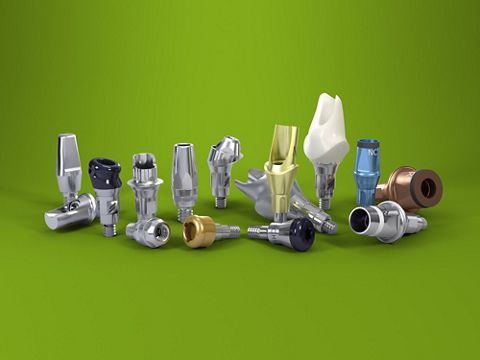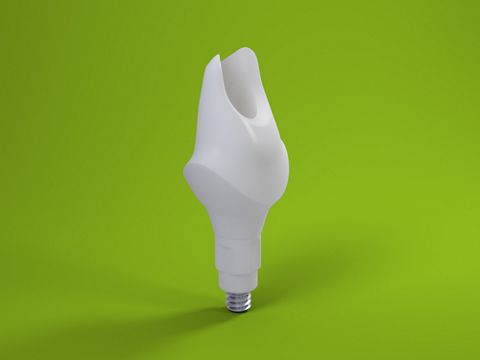“Seemingly ‘similar’ parts from different manufacturers can have serious performance differences“
An Interview with J. Robert Kelly, USA
On the occasion of the recent publication of his latest research in the International Journal of Oral and Maxillofacial Implants*, Professor J. Robert Kelly, a renowned material scientist from the University of Connectitut, was kind enough to grant us an interview. The cited study and the conclusions drawn from it once more show that not all implant abutments are equal and that the use of original prosthetic components is highly recommended for the reliability and success of the restoration.
Professor Kelly, in your latest research, you have tested the fatigue behaviour of zirconia abutments from four major manufacturers. Can you tell us more about it?
This project examined commercially available custom CAD/CAM abutments for failure behaviour and failure origins to gain insights into the role of abutment design and manufacturing on their lifetimes. The goal was to perform clinically relevant mechanical testing to provide practitioners with evidence for choosing the designs and materials to protect and benefit their patients and potentially to provide manufacturers with feedback regarding processing and design issues.
“The bottom line of our research is Straumann wins for the all-zirconia abutments, clearly underlining that the manufacturer matters!”
What was the methodology for testing these products?
One implant type was used throughout the entire project: the Straumann® Bone Level Implant (D4.1 mm, H10 mm). Initially, the project was planned for studying four all-zirconia abutments but only two manufacturers still offered such abutments for the chosen implant (Straumann and DENTSPLY ATLANTIS), whereas Nobel Biocare and Glidewell discontinued their all-zirconia abutments. We therefore studied two groups of abutments: two all-zirconia abutments – Straumann CARES® and Dentsply Antlantis – and two titanium-zirconia (Ti-base) hybrids, i.e. Nobel Biocare and Glidewell. All abutments were tested in a dynamic fatigue test set-up (adapted ISO 14801 protocol) aiming at eliminating implant fracture and maximizing stresses in the abutment and implant/abutment connections. The abutment lifetime extrapolation was then calculated from the fatigue test data which allowed us link mechanical tests with clinical relevance.
What have you found out about differences between manufacturers and their origins?
Differences in durability were dramatic and quite unexpected. Contrary to expectations, there was no inherently “best” design between the two groups, all-zirconia or Ti-based. Not so subtle manufacturing differences clearly separated Straumann as being far superior to DENTSPLY ATLANTIS. For the Ti-based systems the Nobel Biocare results were also way better than Glidewell. Our estimate of the time required for 10% of the Straumann abutments to fail was approximately 20 years – clearly well-designed and manufactured. Two distinctly different failure modes were found within each type of abutment (pure zirconia and Ti-base) and both occurred in parts from each manufacturer. For all-zirconia abutments failure occurred either from within the implant, likely prior to screw failure or from the screw seat. For Ti-base abutments failures were due to either titanium tube tearing (at the base of the tube) not involving zirconia fracture or by a combination of de-bonding and zirconia fracture. The bottom line of our research is: Straumann wins for the all-zirconia abutments and Nobel Biocare for the 2-piece abutments – clearly underlining that the manufacturer matters!
Why do the two abutments groups have different results and why can’t they be compared?
All-zirconia abutments are used in situations requiring highest esthetic needs, in the anterior region. Especially in situations with thin gingiva they have a clear esthetic advantage over 2-piece abutments. The excellent clinical success rate of Straumann CARES® ZrO2 abutments is underlined in a series of clinical studies. 2-piece abutments, on the other hand, are typically used in the posterior and premolar regions and therefore are exposed to much higher clinical loads compared to the anterior region. It is therefore obvious that 2-piece abutments need to exhibit higher mechanical stability compared to 1-piece abutments. There are design differences between them worth dwelling on. While the 2-piece abutments do have a continuous column of titanium in the joint, the zirconia is still directly loaded by the crown and it is thinner than in the 1-piece systems. There is also the addition of a bonded interface (zirconia-titanium) that appears to be their weak link with many unknown variables such as bonding technique, materials and cement thickness. Titanium tube tearing may be influenced by tube height, radius of curvature at the tube base joint and the metallurgy of this part. To my knowledge, none of these potential variables have been studied.
“The excellent clinical success rate of Straumann® CARES® ZrO2 abutments is underlined in a series of clinical studies.”
Is it clinically relevant to extrapolate cycles to sextillion cycles?
As already mentioned, the prediction of 10% failure at 20 years is remarkably good for any prosthetic system. Extending this to well, well beyond patient lifetimes seems unnecessary.
Focusing on the full zirconia abutments group, what clinical conclusions can be drawn from the differences between Straumann and DENTSPLY ATLANTIS?
From our study it is clear that Straumann has much better results than DENTSPLY ATLANTIS. Coincidentally, Prof. Marco Ferrari from the University of Siena completed a 3-year clinical study including the DENTSPLY ATLANTIS abutment that we tested. They reported 17% failures during this period, in remarkably good agreement with our laboratory data. Small adjustments in our main extrapolation assumptions, 70 N clinical load and 1.5 million chewing cycles per year, validate our model with his clinical findings.
“From our study it is clear that Straumann has much better results than DENTSPLY ATLANTIS.”
Are you surprised by the fact that what are claimed to be three compatible abutments have much worse rotational play than the original Straumann abutment? How important is it for you to use original components?
Rotational play turned out not to predict fatigue performance in this study, but does clearly reinforce our main finding that seemingly “similar” parts from different manufacturers can have serious performance differences. We clearly identified durability differences, even if the specific cause of poor durability was not identified. As for original components in general, I advise against using lower cost third-party abutments. My experience shows that the quality of their materials is definitely inferior. There is way too much to lose and it is certainly not worth it for a savings of 100 dollars.
* Kelly J.R, Rungruanganunt P. Fatigue Behavior of Computer-Aided Design/Computer-Assisted Manufacture Ceramic Abutments as a Function of Design and Ceramics Processing. International Journal of Oral and Maxillofacial Implants 2016;31(3): 601–609.



